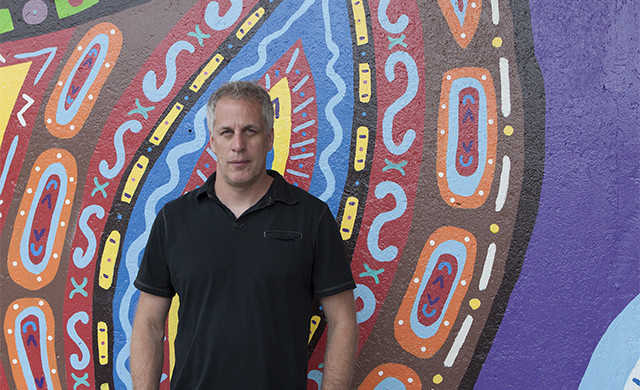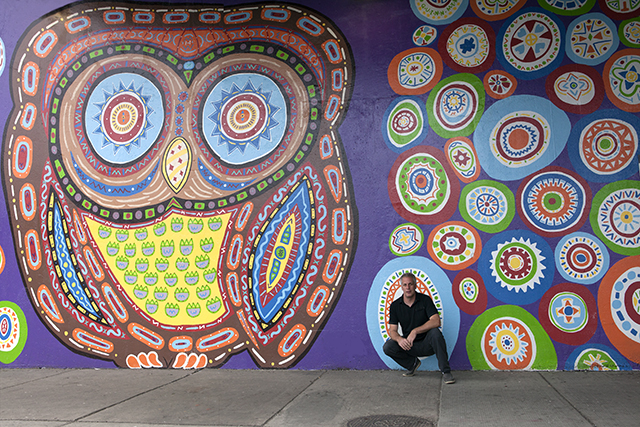Where other Chicago commuters see filthy expressway viaducts or bleak train station walls — that is, if they see them at all — muralist Tony Passero envisions possibilities: outsized felines with piano-key teeth; cubist creatures of red and orange in surrealistic tango; kaleidoscopic owls orbited by Technicolor eggs.
Passero’s public artwork enthralls enough to make drivers screech in their tracks to do a double take. Yet to properly assess his work means leaving your assumptions at the nearest exit ramp. For starters, he’s self-taught. And bottom line, the majority of his city mural work is self-funded, with Passero also donating his time and ideas.
“As I drive around our city I note places that could use a makeover or transformation,” say Passero, whose last name comes from Cape di Passero, the area of Sicily his paternal grandfather hailed from. (Passero’s mother was Irish.) “I then try to tap into the pulse of the surrounding community and its local flavor by reading up about the area.”
Yet Passero, 48, doesn’t just tap into a neighborhood’s pulse: he celebrates it by culling beauty from the bleak. There are of course hurdles to clear (with aldermen and transportation officials) and bridges to build (with community members). But often the execution phase proves the most exhausting: You can’t just slap a few coats of paint on a concrete wall and call it good.
“Murals can be pretty daunting, not only because of their size and scale, but also because of all the physical work that needs to go in cleaning and prepping,” Passero says. “Most of the locations are underneath neglected bridges or viaducts—and things like rust leaks, cracked walls, trash removal and even pigeon abatement need to be addressed first.” Afterwards his pieces need sealing to protect them from the elements and graffiti.
Given the arresting quality of his public art, it’s hard to believe Passero (a.k.a Tony Sparrow) created his first public mural, the aforementioned “Hep Cat,” in the Spring of 2103. It’s located on Cicero Avenue just past Lawrence Avenue, and worth the drive to see. But to hear Passero describe it, this kitty had a difficult birth.
“I probably made every mistake one could make on that project but I stuck with it and used each misstep as a lesson learned,” he recalls. He credits Arts Alive Chicago founder Cyd Smillie for showing unwavering support, and cites the unexpected aid of a local ally.
“A neighborhood artist, Jerry Z. Rogowski, decided to join in,” Passero says. “He was formally trained in his native Poland and is an incredibly talented artist who’s so giving of his talent and time that it can be unsettling.”
The same can be said of Passero, who could just as easily use his energy and resources to make art for profit. (He does sell artwork via his website.) It all boils down to his generous motivations, which owe quite a bit to his Italian lineage.
“Why do I do it? I think it goes back to that Italian adage, ‘Keep your property well-maintained and clean,’” he notes. “And if your neighbor does not or cannot do the same, then do it for them.”
Yet Passero, a Chicago native, also wants to give back: “As someone who thinks and cares about history deeply, my public artwork allows me to leave a bit of legacy—and hopefully become part of the city’s rich history.”
To learn more about the artwork and murals of Tony Passero, visit his website at tonypassero.com.
 Fra Noi Embrace Your Inner Italian
Fra Noi Embrace Your Inner Italian










